Olympus microscopes and photomicrographic equipment
Photo eyepieces
Introduction
Olympus has made at least 4 ranges of photo eyepieces (also known as photographic eyepieces or projection eyepieces), each suited to different types of objective.
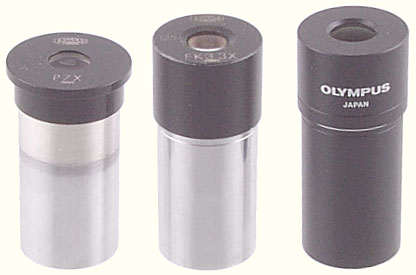
Olympus P, FK and NFK Photo Eyepieces
The photo eyepieces fit inside the circular dovetail that is found on some Olympus microscopes, on some Olympus trinocular heads and photo tubes, and on the eyepiece adapters.
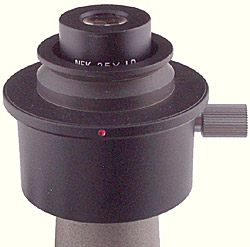
NFK eyepiece in a PM-ADF eyepiece adapter on an Olympus BH-TR45 trinocular head
The bottom of the Photomicro Adapter L (or the PM10, PM20 and PM30 photomicrographic systems) clamps on to the circular dovetail. The top of the Adapter L has the same fitting as the rear of an Olympus OM lens and attaches to the camera body in the normal way; you can use an Olympus OM camera body, or the SC 35 Type 12 body, or a digital SLR with a suitable adapter.
The “125” that is marked on the FK, NFK and PE photo eyepieces indicates that they are designed to give optimum performance at a 125 mm projection distance.
The photo eyepieces are designed to provide a rectangular camera image that is cropped from the circular image produced by the objective; they do not produce a circular image in the camera. For the best match between what you see through the viewing eyepieces and what the camera records, the field number (FN) for the camera image should be the same as, or slightly less than, the field number of the viewing eyepiece.
The Olympus WHK 10×/20 L viewing eyepieces for the BH-2 or IMT-2 microscopes have a field number of 20. The CWHK 10×/18 L viewing eyepieces for the CH-2 or CK2 microscopes and the Bi WF 10× viewing eyepieces for the BH microscopes have a field number of 18. For 35 mm film (or a full-frame digital SLR like the Canon EOS 5D Mark II), the best match is a 2.5× photo eyepiece. For an APS-C sensor, the best match is a 1.67× or 2× photo eyepiece.
The following table shows the field numbers for the 3 most common film and sensor formats with the 7 available magnifications of photo eyepieces.
| Photo eyepiece magnification | 1.67× | 2× | 2.5× | 3.3× | 4× | 5× | 6.7× |
|---|---|---|---|---|---|---|---|
| 35 mm (36×24 mm), diagonal 43.3 mm | n/a | n/a | 17.3 | 13.0 | 10.8 | 8.7 | 6.5 |
| APS-C (22.2×14.8 mm), diagonal 26.7 mm | 15.3 | 13.4 | 10.7 | 8.0 | 6.7 | 5.3 | 4.0 |
| Four Thirds (17.3×13 mm), diagonal 21.6 mm | 12.3 | 10.8 | 8.6 | 6.5 | 5.4 | 4.3 | 3.2 |
Going digital
There are no moving or electronic connections between the photo eyepieces and the Photomicro Adapter L and the Olympus OM camera body, so the main considerations are that the sensor in a digital SLR is at the same distance as the film in an OM camera, and that the camera’s field of view is comparable to that through the viewing eyepieces.
125 mm projection distance
Olympus specifies the FK, NFK and PE photo eyepieces as having a projection distance of 125 mm, but gives no indication of how this is measured. If we start with a simple Olympus photomicrographic system (OM 35 mm SLR plus Photomicro Adapter L, so no mirrors, prisms or lenses in the adapter) and measure 125 mm down from the film plane, we arrive at a point a few millimetres above the top of the photo eyepiece, presumably the location of the exit pupil.
If you use an all-Olympus system, or substitute a Canon EOS digital SLR with a suitable adapter, then the film or sensor will automatically be at the correct distance to obtain both optimum performance from the photo eyepiece and parfocality with the viewing eyepieces in a BH-2, IMT-2 or Vanox microscope.
If you want to use the photo eyepieces with other equipment, then the distance from the ledge on which the top section of an FK or NFK eyepiece rests to the film or sensor plane is 150.0 mm. This measurement was kindly provided by Richard J. Kinch (Making Digital Camera Microscope Adapters).
NFK Eyepieces (LD Series)
These compensating photo eyepieces were designed for use with the long-barrel 45 mm parfocal objectives (including the DPlan, SPlan, SPlan Apo, MSPlan and Neo SPlan series) for Olympus trinocular compound microscopes such as the Vanox (AHB-LB), BH-2, CH-2, CH40, CK2, CK40 and IMT-2. They are also intended for use with trinocular versions of the SZH, SZH10, SZ4045, SZ6045 and SZ1145 stereo microscopes. These eyepieces are not suitable for use as viewing eyepieces, and some of them are so long that they touch the prisms if they are inserted in the binocular tubes.
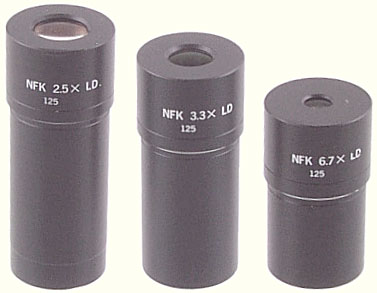
Olympus 2.5×, 3.3× and 6.7× NFK LD photo eyepieces
The Vanox, the IMT-2, the BH2-TR30, BH2-SWTR30 and BH2-TTR trinocular heads, and the SZ-PT and SZH-PT photo tubes have built-in eyepiece adapters for the NFK photo eyepieces, but they can also be used with other trinocular microscopes with the aid of the PM-ADF Eyepiece Adapter, which is also known as the “FK Adapter” or the “Eyepiece Adapter FK”.
| NFK | 1.67× 125 | 2.5× LD 125 | 3.3× LD 125 | 5× LD 125 | 6.7× LD 125 |
|---|---|---|---|---|---|
| Field number (FN) | 21.6 | 16.7 | 12.5 | 8.8 | |
| Length | 74.5 mm | 63.8 mm | 56.1 mm | 51.5 mm | 44.0 mm |
| Length of top section | 19.0 mm | 17.8/18.3 mm | 18.5/18.7 mm | 19.0 mm | 19.0/19.1 mm |
| Diameter (top) | 24.8 mm | 24.8 mm | 24.8 mm | 24.8 mm | 24.8 mm |
| Diameter (body) | 23.1 mm | 23.1 mm | 23.1 mm | 23.1 mm | 23.1 mm |
| Weight | 68.6 gm | 49.3/49.6 gm | 40.5/40.3 gm | 43.3 gm | 36.2/36.3 gm |
| Microscope ref. | 2-LC898 | 2-LC894 | 2-LC895 031176 |
2-LC896 | 2-LC897 |
| US catalog no. | 105-060 | 105-061 | 105-062 | 105-063 | |
| Film or sensor format | APS-C, Four Thirds, video or 16 mm cine | 35 mm (24×36 mm) | Polaroid Type 100 (3¼″×4¼″) | Large format | Large format |
| Magnification relative to 1.67× | 1× | 1.5× | 2× | 3× | 4× |
| Magnification relative to 2.5× | 0.67× | 1× | 1.33× | 2× | 2.67× |
The NFK 1.67× photo eyepiece works well with digital SLRs that use an APS-C sensor (22.2×14.8 mm), such as the Canon EOS 7D, 50D or 550D. With this combination the rectangular camera image (FN 15.3) fits inside the circular field of view of the WHK 10×/20 L viewing eyepieces (FN 20).
The NFK 1.67× is also the best available match for a Four Thirds sensor (17.3×13 mm), but the camera’s field of view (FN 12.3) is significantly smaller than the viewing eyepieces. The NFK 1.67× does not cover the full frame of 35 mm film, because it was designed for use with video cameras with a 2/3″ sensor (11 mm diagonal) and the MTV-3 C-mount adapter. The NFK 1.67× is too long to be used with the SZ-PT phototube on an SZ-4045 and similar stereo microscopes.
The NFK 2.5× photo eyepiece was intended for use with 35 mm cameras (36×24 mm); with this combination the rectangular camera image (FN 17.3) fits just inside the circular field of view of the WHK 10×/20 L viewing eyepieces (FN 20). The NFK 2.5× photo eyepiece is also a good match for a full-frame digital SLR such as the Canon EOS 5D Mark II and Mark III. The NFK 2.5× photo eyepiece is also used with video cameras with a 1″ sensor (16 mm diagonal) and the MTV-3 C-mount adapter.

Camera image areas with Olympus NFK LD photo eyepieces, relative to WHK 10×/20 L viewing eyepieces
The 3.3×, 5× and 6.7× eyepieces can also be used with 35 mm cameras and digital SLRs when higher magnification (with a correspondingly smaller field of view) is required.
For digital and for 35 mm film, the picture magnification on the sensor or film is determined by the formula:
NFK eyepiece power × objective power
The large format film camera backs include a relay lens, and the picture magnification on the film is determined by the formula:
3 × NFK eyepiece power × objective power
The NFK photo eyepieces are not suitable for use with the older 36.65 mm objectives used on the BH and earlier microscopes, nor are they suitable for use with the UIS and UIS-2 infinity objectives.
In addition to their use in photomicrography, the NFK eyepieces are used with the AH-MPS-W and AH-SPS-W projection screens, the BH2-DA drawing attachment, the BH-WP wall projection prism and the MTV-3 C-mount adapter.
Versions
Within the LD series, there are versions with slight differences in the length of the top section, the weight and the multicoating.
The NFK eyepieces do not provide a way for users to add an eyepiece reticle, but Olympus made a few that have a reticle glued in place.
Some NFK eyepieces are marked “L” instead of “LD”, and differ in length, weight and coating from the common LD versions. These NFK “L” Series photo eyepieces were the predecessors of the “LD” Series.
Instruction booklet
Reproduced with permission from the copyright owner, Olympus Optical Co., Ltd
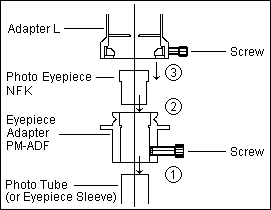
- Attach the Eyepiece Adapter PM-ADF to the photo tube of microscope, and clamp with screw provided.
- Insert the selected Eyepiece NFK into the Eyepiece Adapter PM-ADF.
- Fit the Adapter L over the Eyepiece Adapter PM-ADF pushing all the way down, and clamp the entire camera assembly.
OLYMPUS
OLYMPUS OPTICAL CO., LTD.
43-2 Hatagaya 2-chome, Shibuya-ku, Tokyo, Japan
NFK Eyepieces (L Series)
These compensating photo eyepieces are much less common than the LD series. They were the first version of the NFK eyepieces, and they are included in a 1980 German catalogue of LB objectives. The LD and L series differ in their length and weight and in the colour of their multicoating, and there is no circular indentation just below “125” in the L versions. These eyepieces are not suitable for use as viewing eyepieces, and some of them are so long that they touch the prisms if they are inserted in the binocular tubes.
They were designed for use with the long-barrel 45 mm parfocal objectives for Olympus trinocular compound microscopes such as the Vanox (AHB-LB), BH-2, CH-2 and CK2.
| NFK | 2.5× L 125 | 3.3× L 125 | 5× L 125 | 6.7× L 125 |
|---|---|---|---|---|
| Field number | 23.0 | 18.4 | 12.4 | 8.8 |
| Length | 65.6 mm | 46.6 mm | ||
| Length of top section | 18.8 mm | 19.0 mm | ||
| Diameter (top) | 24.8 mm | 24.8 mm | 24.8 mm | 24.8 mm |
| Diameter (body) | 23.1 mm | 23.1 mm | 23.1 mm | 23.1 mm |
| Weight | 45.0 gm | 34.8 gm | ||
| Microscope ref. | ||||
| US catalog no. | ||||
| Film format | 35 mm (24×36 mm) | Polaroid Type 100 (3¼″×4¼″) | Large format | Large format |
| Magnification relative to 2.5× | 1× | 1.33× | 2× | 2.67× |
The NFK 2.5× photo eyepiece was intended for use with 35 mm cameras; with this combination the rectangular camera image fits just inside the circular field of view of the WHK 10×/20 L viewing eyepieces. The 3.3×, 5× and 6.7× eyepieces can also be used with 35 mm cameras when higher magnification (with a correspondingly smaller field of view) is required.
For digital and for 35 mm film, the picture magnification on the sensor or film is determined by the formula:
NFK eyepiece power × objective power
The large format film camera backs include a relay lens, and the picture magnification on the film is determined by the formula:
3 × NFK eyepiece power × objective power
FK Eyepieces
These compensating photo eyepieces were designed for use with the short-barrel 36.65 mm objectives for compound microscopes such as the Vanox (AH), BH, CH, E & F, K, G & H, MF & N, CK, IM, FLM, and POM & POS and with the SZ-III-Tr trinocular stereo microscope. The Vanox has a built-in eyepiece adapter, but other trinocular microscopes can use the PM-ADF Eyepiece Adapter, which is also known as the “FK Adapter” or the “Eyepiece Adapter FK”. These eyepieces are not suitable for use as viewing eyepieces, and some of them are so long that they touch the prisms if they are inserted in the binocular tubes.
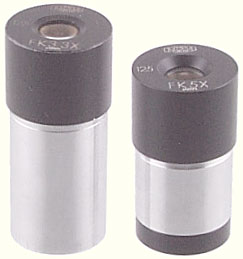
Olympus 3.3× and 5× FK Photo Eyepieces
The 2.5× eyepiece was intended for use with 35 mm cameras; there were 2 versions of this eyepiece, and perhaps of the others too. The 3.3×, 5× and 6.7× eyepieces can also be used with 35 mm cameras when higher magnification (with a correspondingly smaller field of view) is required.
| FK | 2.5× 125 (long) | 2.5× 125 (short) | 3.3× 125 | 5× 125 | 6.7× 125 |
|---|---|---|---|---|---|
| Field number (FN) | 17.3 | 17.3 | 13.1 | 8.6 | 6.4 |
| Length | 66.2 mm | 59.3 mm | 54.8 mm | 44.4 mm | 43.5 mm |
| Length of top section | 19.4 mm | 18.4 mm | 19.3 mm | 18.9 mm | 18.9 mm |
| Diameter (top) | 24.8 mm | 24.8 mm | 24.8 mm | 24.8 mm | 24.8 mm |
| Diameter (body) | 23.0 mm | 23.0 mm | 23.0 mm | 23.0 mm | 23.0 mm |
| Weight | 61.3 gm | 45 gm | 57.6 gm | 37.1 gm | 42.3 gm |
| Microscope ref. | |||||
| US catalog no. | 205-659 | ||||
| Film format | 35 mm (24×36 mm) | 35 mm (24×36 mm) | Polaroid Type 100 (3¼″×4¼″) | Large format | Large format |
| Magnification relative to 2.5× | 1× | 1× | 1.33× | 2× | 2.67× |
For digital and for 35 mm film, the picture magnification on the sensor or film is determined by the formula:
FK eyepiece power × objective power
The large format film camera backs include a relay lens, and the picture magnification on the film is determined by the formula:
3 × FK eyepiece power × objective power
In addition to their use in photomicrography, the FK eyepieces are used with the A-MPS and BH-MPS projection screens, the BH-DA drawing attachment and the BH-WP wall projection prism.
The FK photo eyepieces are not suitable for use with the newer 45 mm objectives used on the BH-2 microscope, nor are they suitable for use with the UIS and UIS-2 infinity objectives.
Instruction booklet
Reproduced with permission from the copyright owner, Olympus Optical Co., Ltd
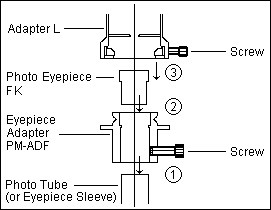
- Attach the Eyepiece Adapter PM-ADF to the photo tube of microscope, and clamp with screw provided.
- Insert the selected Eyepiece FK into the Eyepiece Adapter PM-ADF.
- Fit the Adapter L over the Eyepiece Adapter PM-ADF pushing all the way down, and clamp the entire camera assembly.
OLYMPUS
OLYMPUS OPTICAL CO., LTD.
43-2 Hatagaya 2-chome, Shibuya-ku, Tokyo, Japan
PE Eyepieces
This is the most recent range of photo eyepieces, designed for use with trinocular versions of Olympus compound microscopes that take the UIS and UIS-2 series of infinity-corrected objectives (including the AX, BX, CX, CKX, IX and MX series), and with trinocular versions of the Olympus SZX7, SZX9, SZX12 or SZX16 infinity-corrected stereo microscopes. They fit inside the circular dovetail at the top of the U-DPT, U-SPT, U-VPT, IX-SPT and IX2-SPT photo tubes.
The PE photo eyepieces are available with 2×, 2.5×, 3.3×, 4× and 5× magnifications; the 2.5× eyepiece is intended for use with 35 mm cameras.
| PE | 2× | 2.5× | 3.3× | 4× | 5× |
|---|---|---|---|---|---|
| Length | 55.2 mm | ||||
| Diameter (top) | 26.9 mm | ||||
| Diameter (body) | 24.8 mm | ||||
| Weight | 62.0 gm | ||||
| Microscope ref. | 2-U710 | 2-U720 037081 |
2-U730 037082 |
2-U740 037083 |
2-U750 |
| Film format | Video or 16 mm cine | 35 mm (24×36 mm) | Polaroid Type 100 (3¼″×4¼″) | Large format | Large format |
| Magnification relative to 2× | 1× | 1.25× | 1.67× | 2× | 2.5× |
| Magnification relative to 2.5× | 0.8× | 1× | 1.33× | 1.6× | 2× |
For digital and for 35 mm film, the picture magnification on the sensor or film is determined by the formula:
PE eyepiece power × objective power
The large format film camera backs include a relay lens, and the picture magnification on the film is determined by the formula:
3 × PE eyepiece power × objective power
The PE photo eyepieces are not suitable for use with the 160 mm and 210 mm objectives used on the BH-2 and earlier microscopes, nor are they suitable for use with the MSPlan and Neo SPlan infinity metallurgical objectives for the BH-2. They have a wider diameter than the FK and NFK photo eyepieces, so it is impossible to use them in the BH2-TR30 trinocular head or in the PM-ADF eyepiece adapter.
P Eyepieces
These 5×, 7×, 10× and 15× compensating eyepieces can be used for visual observation as well as for photomicrography. They are an improved Huygenian design for flat-field observation and photomicrography. For photomicrography, they are recommended for use with the JM-Tr and X-Tr trinocular stereo microscopes, and they can also be used with the SZ-III-Tr trinocular stereo microscope and with short-barrel 36.65 mm objectives for compound microscopes such as the BH, CH, E & F, K, G & H, MF & N, CK, IM, FLM, and POM & POS. They are used in conjunction with the PM-ADP Eyepiece Adapter, which is also known as the “P Adapter” or the “Eyepiece Adapter P”.
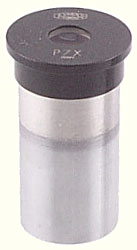 |
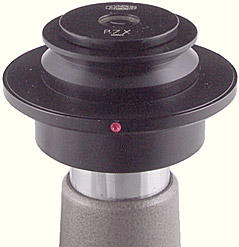 |
| Olympus 7× P Photo Eyepiece | P eyepiece with PM-ADP on Olympus BH-TR45 trinocular head |
For 35 mm film, the picture magnification on the film is determined by the formula:
P eyepiece power × objective power × approximately 0.5
For the older versions that have a raised rim around the top surface and around the lens, the field numbers are 18.8 (5×), 18 (7×), 13 (10×) and 9.5 (15×).
Versions
Older versions have a raised rim around the top surface and around the lens; newer versions have a flat top. There are “Bi” versions intended for use in pairs in binocular heads; these are supposed to have less variation in focal length, in order to minimise eye strain.
There are also LB versions of the P eyepieces, for use with the 45 mm parfocal long-barrel objectives, but the NFK eyepieces are preferred for photomicrography with these objectives.
Instruction booklet
Reproduced with permission from the copyright owner, Olympus Optical Co., Ltd
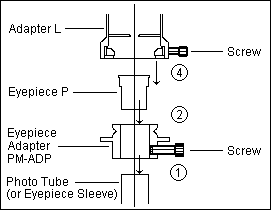
- Fit the Eyepiece Adapter PM-ADP to the photo tube pushing all the way down.
- Insert the Eyepiece P into the photo tube.
- Pressing down the eyepiece against the photo tube slightly, raise the Eyepiece Adapter until it contacts with the eyepiece flange (be sure the eyepiece flange is in contact with both the photo tube and Eyepiece Adapter) and lock the adapter firmly with clamping screw.
- Fit the Adapter L over the Eyepiece Adapter pushing all the way down and clamp the entire camera assembly.
OLYMPUS
OLYMPUS OPTICAL CO., LTD.
43-2 Hatagaya 2-chome, Shibuya-ku, Tokyo, Japan
Send comments or questions to Alan Wood
![]()
Created 2nd May 2004 — Updated 20th April 2025
Copyright © 2004–2025 Alan Wood